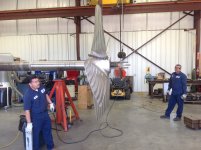You are using an out of date browser. It may not display this or other websites correctly.
You should upgrade or use an alternative browser.
You should upgrade or use an alternative browser.
Barrels
- Thread starter Tim Singleton
- Start date
Dave Coots
64 Chevy 409 10.42 129
Jackie... couple of questions
What kind of tolerances are you allowed on the shafts and what are the propeller diameters? I've had 8" shafts bent in hammermill crushers before, tend to vibrate a bit. Especially when running 1,000 rpm with several hundred pounds of hammers swinging around from the shaft.
What kind of tolerances are you allowed on the shafts and what are the propeller diameters? I've had 8" shafts bent in hammermill crushers before, tend to vibrate a bit. Especially when running 1,000 rpm with several hundred pounds of hammers swinging around from the shaft.
jackie schmidt
New member
What kind of tolerances are you allowed on the shafts and what are the propeller diameters? I've had 8" shafts bent in hammermill crushers before, tend to vibrate a bit. Especially when running 1,000 rpm with several hundred pounds of hammers swinging around from the shaft.
Dave, the majority of the Propeller Shafts we work on are 7 inch diameter to 10 inch diameter. The typical length is around 24 to 30 ft.
When either new or repaired, we strive to keep all of the criticle fits within a few thousandths running truly straight. That includes the Bearing and seal surfaces and the prop and coupling taper fits. The area in between is machined true for balance.
As for Prop size, most of the Inland Tugs we work on are twin screw, 1800 to 3600 HP. An 1800 will typically swing a 72 inch diameter wheel, a 2600 will swing about a 82 inch wheel, and a 3600 will swing a 92 inch wheel on each shaft. On occasion, we will have a larger shaft and wheel come in. One of our customers is G&H Towing, who have a fleet of Harbor Tugs that's handle ships on the Houston Ship Channel. Included in their fleet are six 3500 HP single screw boats which have a single 13 inch shaft and a 12 ft prop.
Here is a picture of one we repaired the shaft and fit the prop for.
The other pic is a 3200 HP Pushboat we did all of the machine shop work for last year. It has two 3512 Catepillar diesels and 8 inch shafts swinging 84 inch wheels.
http://benchrest.com/attachment.php?attachmentid=20535&stc=1&d=1514864956
Attachments
Last edited:
Pete Wass
Well-known member
Yowwwwww
Pete, we straighten shafts at room temperature. The American Bureau of Shipping, (ABS), does not allow heat quench straightning.
We straighten shafts and bent rudder stocks up to 13 inches. Here are four pictures of a 9 inch diameter Rudder stock that we straightened. The first is with the straightening rig in place, getting ready. The next two are the actual straightening, the last, the finished job. Keep in mind, there are quite a few "hits" in between as you work the bend out.
The straightening rig has a 500 ton hydraulic ram. If you look behind the big Lathe, you see our largest one in it's cradle. It has a 750 ton hydraulic ram.
We designed and built these rigs ourselves. They are constructed from T-1 plate. We also have smaller ones for smaller applications, one at 150 and another at 300 tons.
We do this sort of thing on a regular basis.
http://benchrest.com/attachment.php?attachmentid=20529&stc=1&d=1514783143
http://benchrest.com/attachment.php?attachmentid=20530&stc=1&d=1514783256
http://benchrest.com/attachment.php...straight at that time? Happy New Year, Pete
Last edited:
jackie schmidt
New member
That's some mighty big gearing. If I could go back in time and know what I know today, (anybody else ever said that?) I would seek this kind of work to do. Thanks for the pictures.
The question I asked regarding air gauging barrels right after they have been drilled, could one tell if the hole is straight at that time?
Happy New Year,
Pete
Pete, air gaging is used to measure variations in a inside diameter at a specific point. I can't see how it could be used to ascertain how straight a ID is with it's self.
F
Frank Green
Guest
Would air gauging be able to see the hole wasn't straight before reaming begins if the test was done?
No air gauging just measures bore or groove size. Has nothing to do with measuring straightness.
I've banged my head over the years on finding or making a machine to measure the bore straightness after drilling or thru out the manufacturing process. Only machine I could find a few years ago could only check a piece about 12" long and it was like a $1m.
You have the physical eye check which is one way.
You have the Gov't check system....which for example on a 5.56mm barrel (.219" bore) they drop a gauge pin thru the bore. If memory serves me right the pin is 6" long and is like .212" diameter and has to drop/pass freely thru the bore. Well that's .007" total clearance and in our opinion a country mile! So with that being said....
I was asked this question by a Canadian Military armorer in regards to straightness.....First thing I said have you gotten any barrels from us that didn't shoot? Answer was no. Then I told him our rifling heads are 7.5" long and the diameter of the head is only. .0008" under bore size. I'll guarantee that if bore or barrel is that bent or crooked, call it what you want that I will guarantee that the head doesn't pass freely thru the bore you won't see the barrel and we will scrap $3k or so of tooling!
Later, Frank
F
Frank Green
Guest
Pete, air gaging is used to measure variations in a inside diameter at a specific point. I can't see how it could be used to ascertain how straight a ID is with it's self.
Sorry Jackie! We we're posting at the same time and wasn't trying to hijack ya either!
Later, Frank



